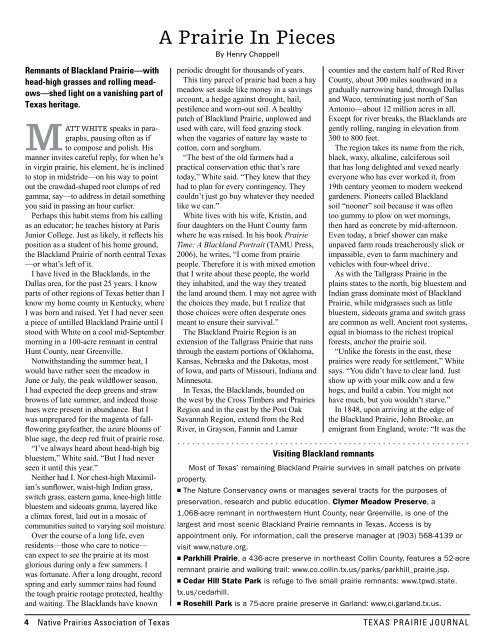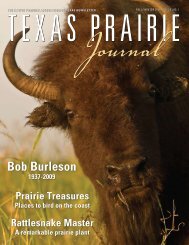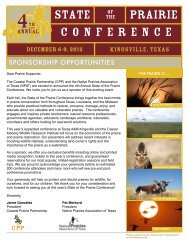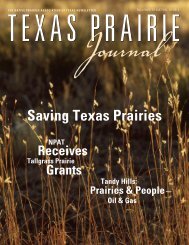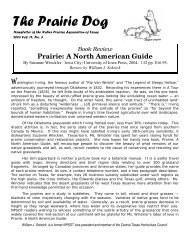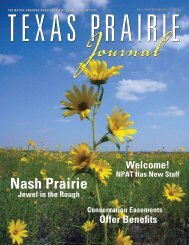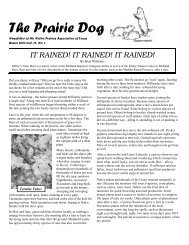Prairie in Pieces - Native Prairies Association of Texas
Prairie in Pieces - Native Prairies Association of Texas
Prairie in Pieces - Native Prairies Association of Texas
Create successful ePaper yourself
Turn your PDF publications into a flip-book with our unique Google optimized e-Paper software.
emnants <strong>of</strong> Blackland <strong>Prairie</strong>—with<br />
head-high grasses and roll<strong>in</strong>g meadows—shed<br />
light on a vanish<strong>in</strong>g part <strong>of</strong><br />
<strong>Texas</strong> heritage.<br />
MATT whiTe speaks <strong>in</strong> paragraphs,<br />
paus<strong>in</strong>g <strong>of</strong>ten as if<br />
to compose and polish. His<br />
manner <strong>in</strong>vites careful reply, for when he’s<br />
<strong>in</strong> virg<strong>in</strong> prairie, his element, he is <strong>in</strong>cl<strong>in</strong>ed<br />
to stop <strong>in</strong> midstride—on his way to po<strong>in</strong>t<br />
out the crawdad-shaped root clumps <strong>of</strong> red<br />
gamma, say—to address <strong>in</strong> detail someth<strong>in</strong>g<br />
you said <strong>in</strong> pass<strong>in</strong>g an hour earlier.<br />
Perhaps this habit stems from his call<strong>in</strong>g<br />
as an educator; he teaches history at Paris<br />
Junior College. Just as likely, it reflects his<br />
position as a student <strong>of</strong> his home ground,<br />
the Blackland <strong>Prairie</strong> <strong>of</strong> north central <strong>Texas</strong><br />
—or what’s left <strong>of</strong> it.<br />
I have lived <strong>in</strong> the Blacklands, <strong>in</strong> the<br />
Dallas area, for the past 25 years. I know<br />
parts <strong>of</strong> other regions <strong>of</strong> <strong>Texas</strong> better than I<br />
know my home county <strong>in</strong> Kentucky, where<br />
I was born and raised. Yet I had never seen<br />
a piece <strong>of</strong> untilled Blackland <strong>Prairie</strong> until I<br />
stood with White on a cool mid-September<br />
morn<strong>in</strong>g <strong>in</strong> a 100-acre remnant <strong>in</strong> central<br />
Hunt County, near Greenville.<br />
Notwithstand<strong>in</strong>g the summer heat, I<br />
would have rather seen the meadow <strong>in</strong><br />
June or July, the peak wildflower season.<br />
I had expected the deep greens and straw<br />
browns <strong>of</strong> late summer, and <strong>in</strong>deed those<br />
hues were present <strong>in</strong> abundance. But I<br />
was unprepared for the magenta <strong>of</strong> fallflower<strong>in</strong>g<br />
gayfeather, the azure blooms <strong>of</strong><br />
blue sage, the deep red fruit <strong>of</strong> prairie rose.<br />
“I’ve always heard about head-high big<br />
bluestem,” White said. “But I had never<br />
seen it until this year.”<br />
Neither had I. Nor chest-high Maximilian’s<br />
sunflower, waist-high Indian grass,<br />
switch grass, eastern gama, knee-high little<br />
bluestem and sideoats grama, layered like<br />
a climax forest, laid out <strong>in</strong> a mosaic <strong>of</strong><br />
communities suited to vary<strong>in</strong>g soil moisture.<br />
Over the course <strong>of</strong> a long life, even<br />
residents—those who care to notice—<br />
can expect to see the prairie at its most<br />
glorious dur<strong>in</strong>g only a few summers. I<br />
was fortunate. After a long drought, record<br />
spr<strong>in</strong>g and early summer ra<strong>in</strong>s had found<br />
the tough prairie rootage protected, healthy<br />
and wait<strong>in</strong>g. The Blacklands have known<br />
A <strong>Prairie</strong> <strong>in</strong> <strong>Pieces</strong><br />
By henry Chappell<br />
periodic drought for thousands <strong>of</strong> years.<br />
This t<strong>in</strong>y parcel <strong>of</strong> prairie had been a hay<br />
meadow set aside like money <strong>in</strong> a sav<strong>in</strong>gs<br />
account, a hedge aga<strong>in</strong>st drought, hail,<br />
pestilence and worn-out soil. A healthy<br />
patch <strong>of</strong> Blackland <strong>Prairie</strong>, unplowed and<br />
used with care, will feed graz<strong>in</strong>g stock<br />
when the vagaries <strong>of</strong> nature lay waste to<br />
cotton, corn and sorghum.<br />
“The best <strong>of</strong> the old farmers had a<br />
practical conservation ethic that’s rare<br />
today,” White said. “They knew that they<br />
had to plan for every cont<strong>in</strong>gency. They<br />
couldn’t just go buy whatever they needed<br />
like we can.”<br />
White lives with his wife, Krist<strong>in</strong>, and<br />
four daughters on the Hunt County farm<br />
where he was raised. In his book <strong>Prairie</strong><br />
Time: A Blackland Portrait (TAMU Press,<br />
2006), he writes, “I come from prairie<br />
people. Therefore it is with mixed emotion<br />
that I write about these people, the world<br />
they <strong>in</strong>habited, and the way they treated<br />
the land around them. I may not agree with<br />
the choices they made, but I realize that<br />
those choices were <strong>of</strong>ten desperate ones<br />
meant to ensure their survival.”<br />
The Blackland <strong>Prairie</strong> Region is an<br />
extension <strong>of</strong> the Tallgrass <strong>Prairie</strong> that runs<br />
through the eastern portions <strong>of</strong> Oklahoma,<br />
Kansas, Nebraska and the Dakotas, most<br />
<strong>of</strong> Iowa, and parts <strong>of</strong> Missouri, Indiana and<br />
M<strong>in</strong>nesota.<br />
In <strong>Texas</strong>, the Blacklands, bounded on<br />
the west by the Cross Timbers and <strong>Prairie</strong>s<br />
Region and <strong>in</strong> the east by the Post Oak<br />
Savannah Region, extend from the Red<br />
River, <strong>in</strong> Grayson, Fann<strong>in</strong> and Lamar<br />
visit<strong>in</strong>g Blackland remnants<br />
counties and the eastern half <strong>of</strong> Red River<br />
County, about 300 miles southward <strong>in</strong> a<br />
gradually narrow<strong>in</strong>g band, through Dallas<br />
and Waco, term<strong>in</strong>at<strong>in</strong>g just north <strong>of</strong> San<br />
Antonio—about 12 million acres <strong>in</strong> all.<br />
Except for river breaks, the Blacklands are<br />
gently roll<strong>in</strong>g, rang<strong>in</strong>g <strong>in</strong> elevation from<br />
300 to 800 feet.<br />
The region takes its name from the rich,<br />
black, waxy, alkal<strong>in</strong>e, calciferous soil<br />
that has long delighted and vexed nearly<br />
everyone who has ever worked it, from<br />
19th century yeomen to modern weekend<br />
gardeners. Pioneers called Blackland<br />
soil “nooner” soil because it was <strong>of</strong>ten<br />
too gummy to plow on wet morn<strong>in</strong>gs,<br />
then hard as concrete by mid-afternoon.<br />
Even today, a brief shower can make<br />
unpaved farm roads treacherously slick or<br />
impassible, even to farm mach<strong>in</strong>ery and<br />
vehicles with four-wheel drive.<br />
As with the Tallgrass <strong>Prairie</strong> <strong>in</strong> the<br />
pla<strong>in</strong>s states to the north, big bluestem and<br />
Indian grass dom<strong>in</strong>ate most <strong>of</strong> Blackland<br />
<strong>Prairie</strong>, while midgrasses such as little<br />
bluestem, sideoats grama and switch grass<br />
are common as well. Ancient root systems,<br />
equal <strong>in</strong> biomass to the richest tropical<br />
forests, anchor the prairie soil.<br />
“Unlike the forests <strong>in</strong> the east, these<br />
prairies were ready for settlement,” White<br />
says. “You didn’t have to clear land. Just<br />
show up with your milk cow and a few<br />
hogs, and build a cab<strong>in</strong>. You might not<br />
have much, but you wouldn’t starve.”<br />
In 1848, upon arriv<strong>in</strong>g at the edge <strong>of</strong><br />
the Blackland <strong>Prairie</strong>, John Brooke, an<br />
emigrant from England, wrote: “It was the<br />
most <strong>of</strong> <strong>Texas</strong>’ rema<strong>in</strong><strong>in</strong>g Blackland <strong>Prairie</strong> survives <strong>in</strong> small patches on private<br />
property.<br />
■ The Nature Conservancy owns or manages several tracts for the purposes <strong>of</strong><br />
preservation, research and public education. Clymer Meadow Preserve, a<br />
1,068-acre remnant <strong>in</strong> northwestern hunt County, near Greenville, is one <strong>of</strong> the<br />
largest and most scenic Blackland <strong>Prairie</strong> remnants <strong>in</strong> <strong>Texas</strong>. Access is by<br />
appo<strong>in</strong>tment only. For <strong>in</strong>formation, call the preserve manager at (903) 568-4139 or<br />
visit www.nature.org.<br />
■ Parkhill <strong>Prairie</strong>, a 436-acre preserve <strong>in</strong> northeast Coll<strong>in</strong> County, features a 52-acre<br />
remnant prairie and walk<strong>in</strong>g trail: www.co.coll<strong>in</strong>.tx.us/parks/parkhill_prairie.jsp.<br />
■ Cedar Hill State Park is refuge to five small prairie remnants: www.tpwd.state.<br />
tx.us/cedarhill.<br />
■ Rosehill Park is a 75-acre prairie preserve <strong>in</strong> Garland: www.ci.garland.tx.us.<br />
4 native prairies <strong>Association</strong> <strong>of</strong> <strong>Texas</strong> TEXAS prAiriE JournAl


